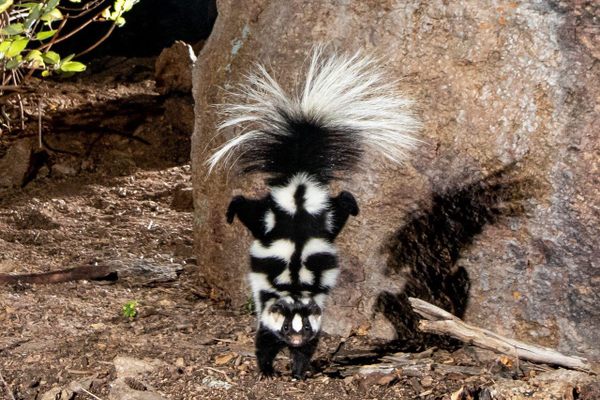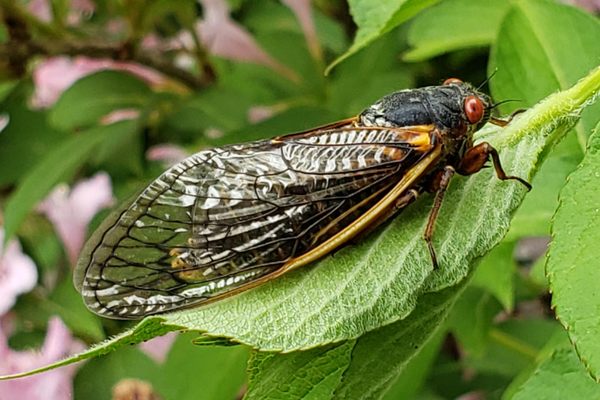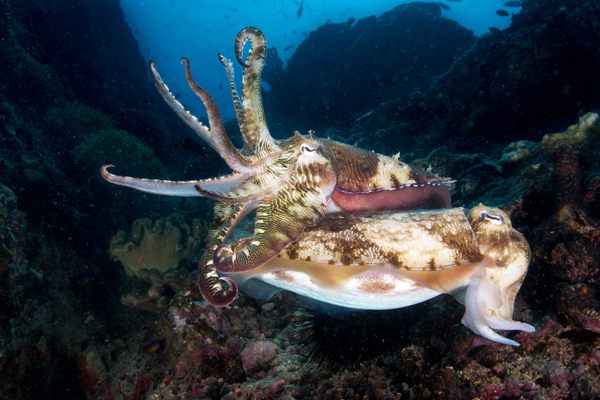Found: A Pescatarian Praying Mantis
Go big or go home.

It’s hard to shock Roberto Battiston with a praying mantis photo. He’s been studying the big-eyed, long-limbed insects for years. But in early 2017, his friend, the conservationist Nayak Manjunath, sent him the image above.
This mantis—a male Hierodula tenuidentata—had a scaly creature trapped between his front legs. Having tossed aside his prey’s iridescent tail, he was gnawing enthusiastically on the rest of it. “I’d never seen something like this!” remembers Battiston. “The praying mantis was eating a fish.”
Most mantids get their calories largely from other insects, such as flies and grasshoppers. If you give one a big snack, though, he’s probably going to go for it. In captive settings, they’ve successfully munched on mice, frogs, newts, snakes, and turtles. Wild mantids have also been known to hunt birds. “They wait for them at the feeders, and sometimes they’re able to catch them” says Battiston. “But these are mostly anecdotal reports.”

Instead, this particular mantis gifted them a robust data set. He lived in the roof garden of Rajesh Puttaswamaiah, another conservationist from Karnataka, India, and the keeper of a small fish pool stocked with guppies and zebrafish. After the insect’s first appearance, he just kept coming back to the pool.
“Not once, but twice—and then a third time, a fourth time,” says Battiston, who was following raptly from his office in Italy. “This was very strange!” Battiston, Manjunath, and Puttaswamaiah kept apprised of his behavior, and the three recently published their findings in the Journal of Orthoptera Research.
Over the course of these five nights, the mantis caught and devoured nine guppies, averaging two per night. He would perch on top of the pool, on a lily pad or a water cabbage leaf, and grab them from beneath the surface. He usually preferred to eat them tail first.

Sometimes, he left their heads in the water while he chewed, effectively eating them alive. He only went fishing after 6:30 p.m.—during the day, he’d spend his time hanging around different plants, resting and catching the occasional bug.
“I was surely surprised to see the mantis eating the guppy,” writes Puttaswamaiah in an email, adding that his five days of observations inspired a number of questions. For instance, why did he always catch guppies, when there were other types of fish available? And while fishing, how was he able to account for how light refracts through water, a difficult task even for experienced human spearfishers?
What’s more, how did he successfully invent what seems to be a new mantis sport? While we’re used to ascribing some form of intelligence to social insects, such as bees and ants, “mantids are solitary predators,” Battiston says. “They only learn from experience.”

This one’s calculated pool-stalking, he continues, suggests that he was capable of surprisingly complex thinking: “Not just remembering a taste, or a stimulus, but a strategy.” Battiston hopes to set up a laboratory experiment, to test whether other mantids can do the same.
For now, all we can do is speculate—after five days of fish feasts, the very hungry mantis disappeared, perhaps aiming to try his luck elsewhere. Look out, chicken coops.
























Follow us on Twitter to get the latest on the world's hidden wonders.
Like us on Facebook to get the latest on the world's hidden wonders.
Follow us on Twitter Like us on Facebook